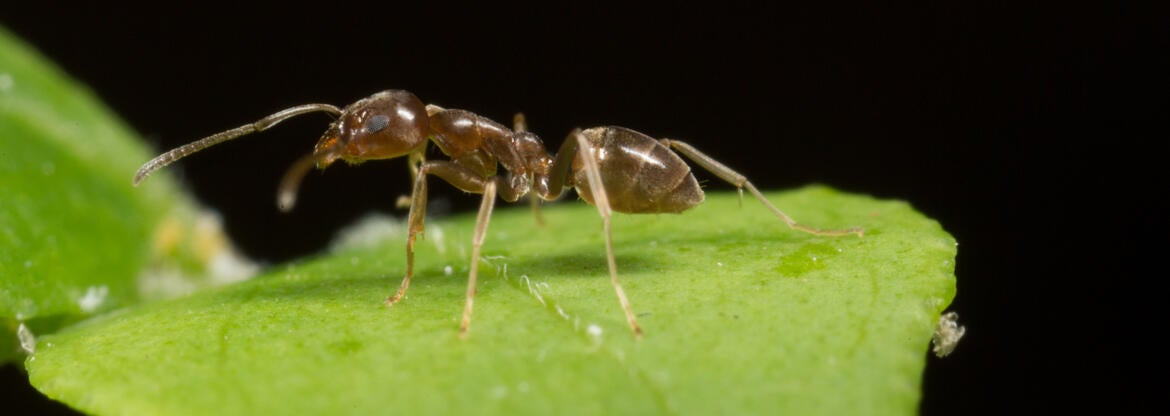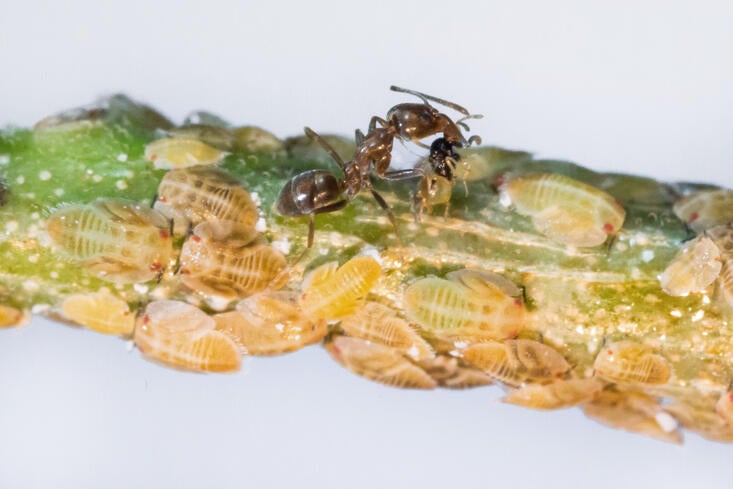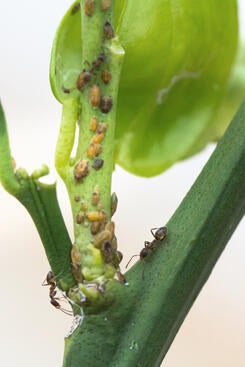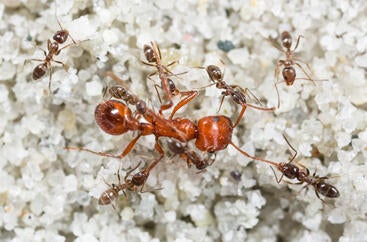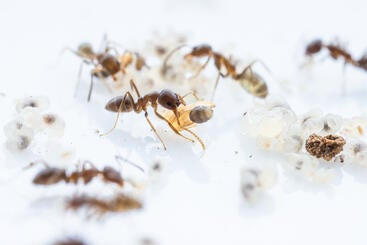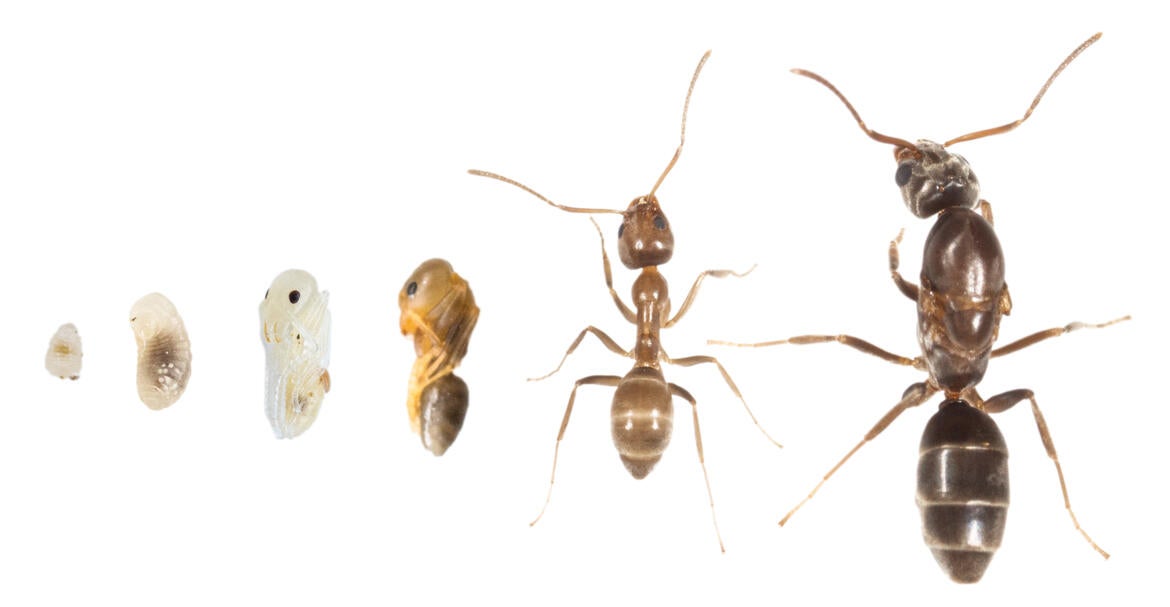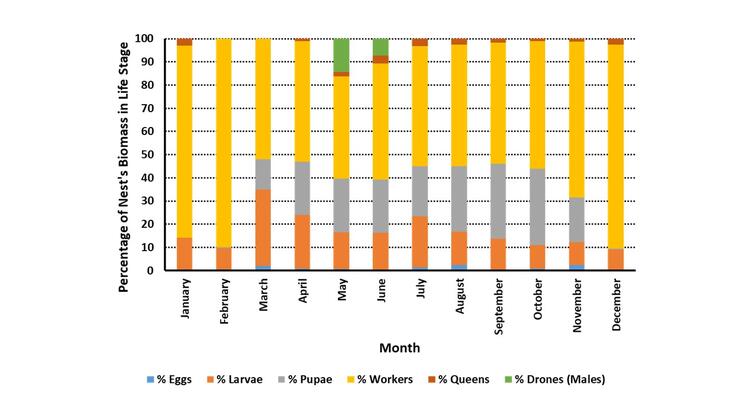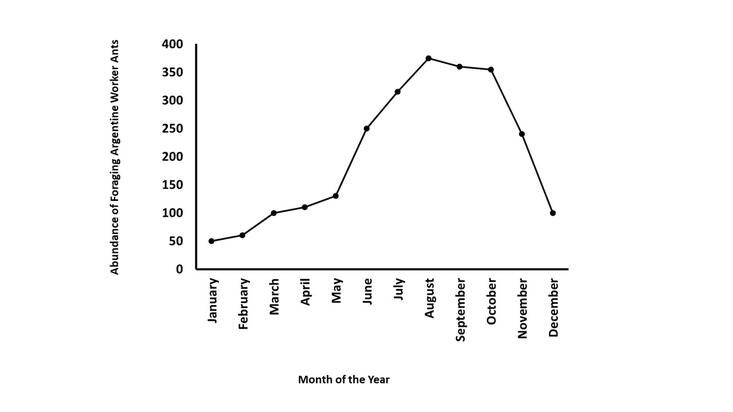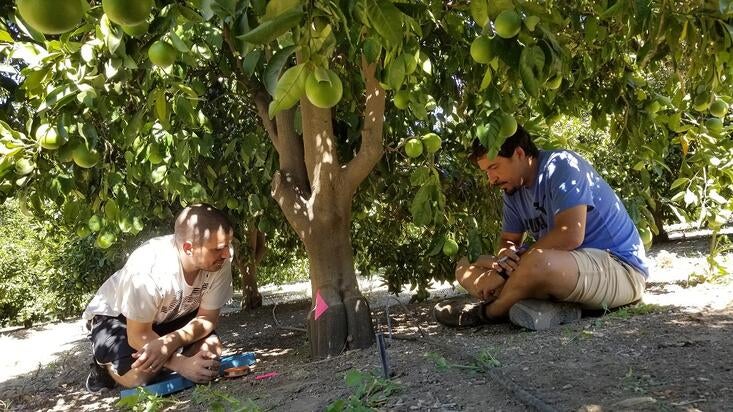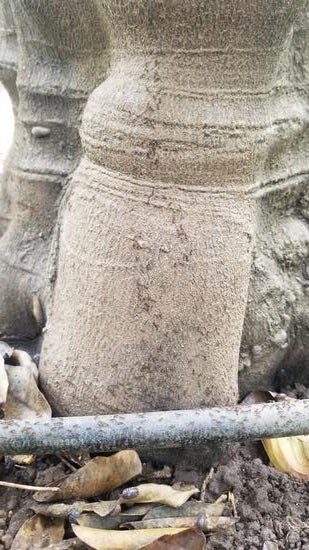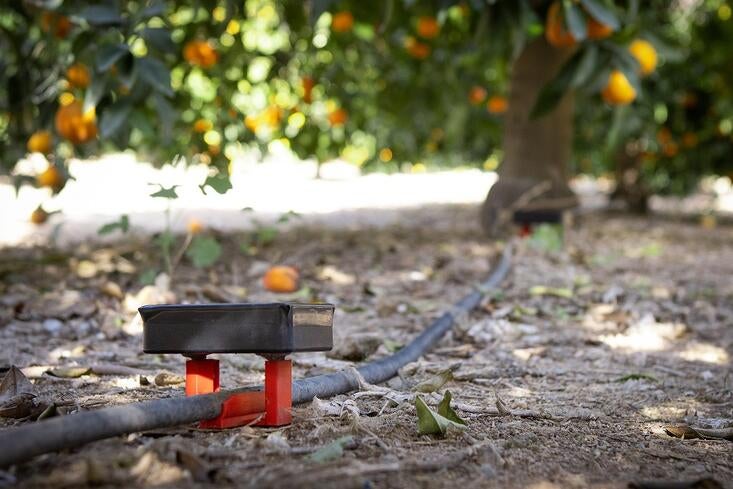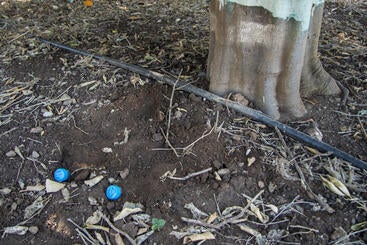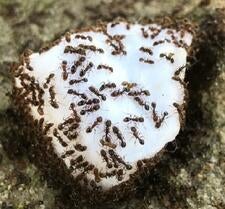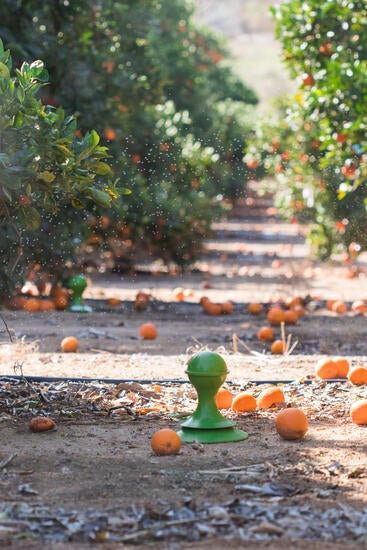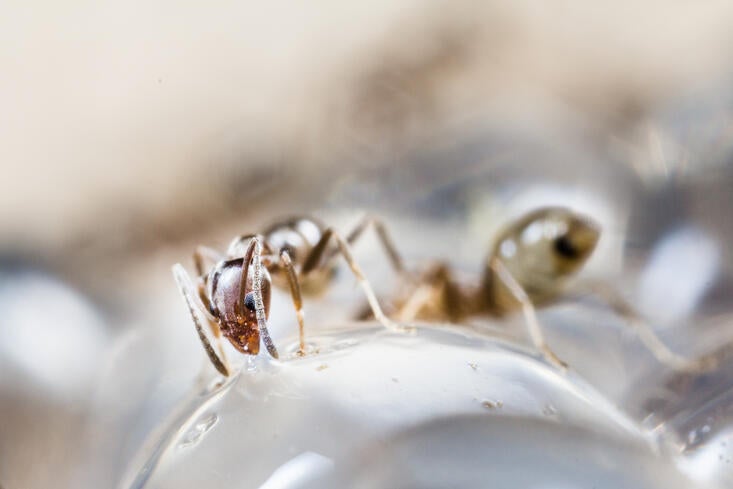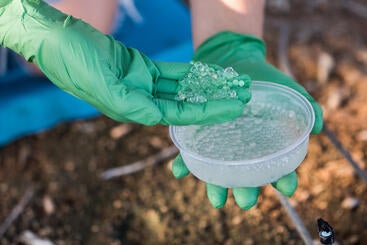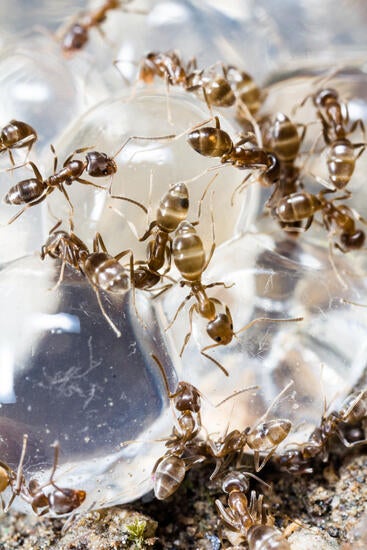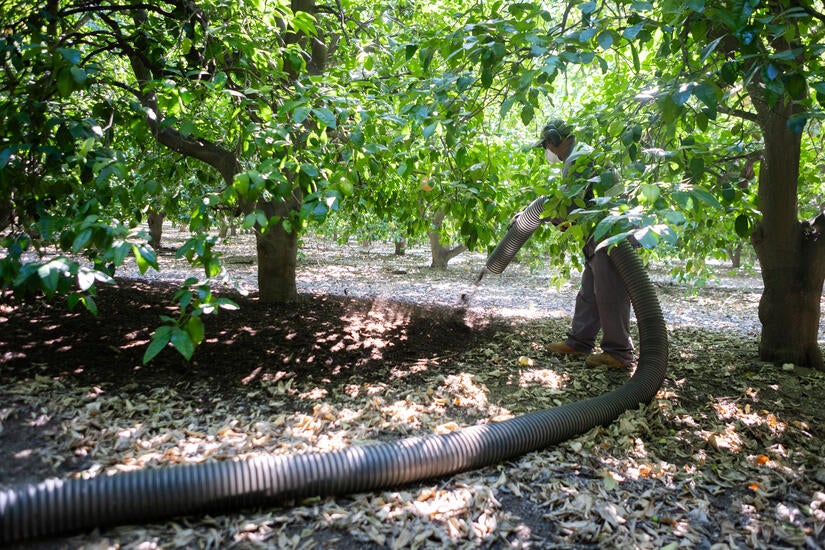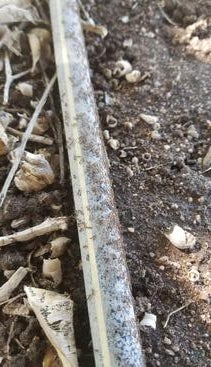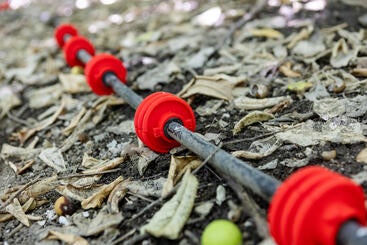Table of Contents
- Argentine Ant Biology and Management in Southern California Citrus Orchards
- Argentine Ant Invasion Biology
- Argentine Ant Biology and Behavior in Southern California Citrus Orchards
- Trial Pheromone Use by Argentine Ant
- Pest Problems Caused by Argentine Ant Food-for-Protection Mutualisms in Southern California Citrus Orchards
- Monitoring of Argentine Ants in Citrus Orchards
- Visual Inspections
- Automated Ant Monitoring
- Monitoring Vials
- Cotton Balls
- Managing Argentine Ants in Citrus Orchards
- Insecticide Management of Argentine Ant
- Liquid Bait Stations
- Hydrogel Beads for Ant Control
- Cultural Control of Pest Ants in Citrus
- Sticky Barriers
- Irrigation Line Management
- Conclusions
Argentine Ant Biology and Management in Southern California Citrus Orchards
Argentine ant, Linepithema humile (Mayr) (Hymenoptera: Formicidae) (Fig. 1 Above), is a non-native and widespread ant species in southern California. It is found commonly in urban, wilderness, and agricultural areas. With respect to agriculture, Argentine ant is very abundant in citrus orchards, and it is a significant pest because of food-for-protection mutualisms it develops with sap-sucking pests, primarily hemipteran species, that include psyllids, mealybugs, soft scales, aphids, mealybugs, and cottony cushion scale. Argentine ants protect sap sucking pests from natural enemies (Fig. 2), and in return for this protection, ants are rewarded with honeydew, a sugary carbohydrate-rich waste product that ants harvest and return to nests to feed nest mates (Fig. 3). This webpage on Argentine ant provides details on the biology and management of this pest in southern California citrus orchards.
Argentine Ant Invasion Biology
an important natural enemy of Asian citrus psyllid.
Photo credit: Mike Lewis, UC Riverside.
colony of Asian citrus psyllid nymphs.
Workers harvest honeydew, a
carbohydrate food source, from nymphs,
and in return for this food, ants protect
their “micro-livestock” from natural enemies,
like the nymph parasitoid, Tamarixia radiata
(see Fig. 2 above).
Photo credit: Mike Lewis, UC Riverside.
Argentine ant, an invasive pest in southern California citrus orchards, is native to the Paraná River drainage area of Argentina, Brazil, Paraguay, and Uruguay in South America. These areas where Argentine ant is native have warm dry summers and cool wet winters which are characteristic of a Mediterranean-like climate (Wetterer et al. 2009), which is very similar to the climate in southern California.
Argentine ant was first detected in the U.S. in Louisiana in 1891, where it was presumed to have been introduced via coffee shipments originating from Brazil (Smith 1936). Populations were first found in Ontario, San Bernardino County California, in 1905 (Smith 1936). Smith (1936) described L. humile as being “………probably the most annoying of the economic ants and a pest of no little importance. Although especially obnoxious to housekeepers, hotel managers, and café owners, it also causes serious losses to orchardists, planters, beekeepers, and others.”
Argentine ant is considered a tramp species, one that is regularly and accidentally moved by humans, and it exhibits a capacity to easily adapt to new areas with suitable climate, habitat, and food sources into which it is introduced. Human activity, such as the movement of ant-infested nursery stock, has significantly enhanced the invasiveness of this pest because it has enabled unintentional movement over large distances. Once introduced into suitable new areas, human activities have created novel and artificial habitats, which are often highly disturbed, and are extremely favorable for Argentine ant. For example, in arid desert-like southern California, Argentine ant populations flourish in well irrigated urban gardens, and orchards with perennial tree and vine crops, like citrus and grapes.
in a citrus orchard. Photo credit: Mike Lewis, UC Riverside.
The behavior, reproductive biology, and genetic structure of invasive L. humile populations also contribute to its invasiveness. Argentine ant is capable of undergoing rapid expansive population growth following establishment in new areas which often results in this pest outcompeting and displacing native ant species (Vega and Rust 2001) (Fig. 4). Colonies, once established, tend to be very large, and aggressive foraging workers overwhelm food sources, enabling them to dominate large territories, which results in the exclusion of competing species. Subterranean nests often have multiple queens (i.e., they are polygynous) and colonies occupy multiple spatially separated nests (i.e., colonies are polydomous). Argentine ant colonies undergo budding (i.e., sociotomy), a process that results in new nests when one or more fertile queens and a group of workers leave an established nest and move to a new nest site that may be in close proximity to source nests (Vega and Rust 2001)

different colonies. Photo credit: Mike Lewis, UC Riverside.
The behavior, reproductive biology, and genetic structure of invasive L. humile populations also contribute to its invasiveness. Argentine ant is capable of undergoing rapid expansive population growth following establishment in new areas which often results in this pest outcompeting and displacing native ant species (Vega and Rust 2001) (Fig. 4). Colonies, once established, tend to be very large, and aggressive foraging workers overwhelm food sources, enabling them to dominate large territories, which results in the exclusion of competing species. Subterranean nests often have multiple queens (i.e., they are polygynous) and colonies occupy multiple spatially separated nests (i.e., colonies are polydomous). Argentine ant colonies undergo budding (i.e., sociotomy), a process that results in new nests when one or more fertile queens and a group of workers leave an established nest and move to a new nest site that may be in close proximity to source nests (Vega and Rust 2001)
Argentine Ant Biology and Behavior in Southern California Citrus Orchards
Photo credit: Mike Lewis, UC Riverside.
Argentine ants are small, measuring about 1/8 inch in length, and are typically light to dark brown in color. They have a single node between their thorax and abdomen, distinguishing them from other ant species. [UC IPM Identification Guide to California Ants. © 2012 Regents of the University of California. Used by permission] Workers have a slender body with a distinct constricted waist, the petiole. In natural, agricultural, and urban areas, Argentine ants build nests in areas where they are protected. Nests can be found underground in soil, underneath rocks, logs, and flower pots, within cracks in concrete pavement or voids within walls. Moist areas are particularly attractive nesting sites for Argentine ants.
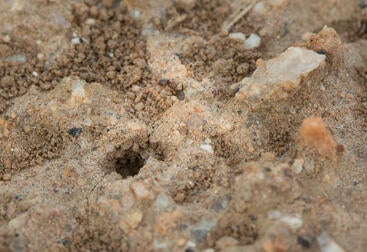
citrus orchard. Note the small mounds of fine soil that
have been excavated to form the underground nest and
piled near the nest entrance.
Photo credit: Mike Lewis, UC Riverside.
In citrus orchards, subterranean nests may occupy ~ 1m2 and nests are honeycombed with chambers and passageways. The only physical surface evidence of the existence of a nest are small piles of fine dirt that have been excavated by workers (Markin 1970) (Fig. 6). Argentine ant nests are not permanent. Under adverse conditions, such as flooding or drying, nesting sites will be abandoned and nest inhabitants will move (non-motile stages, like pupae, will be moved by workers to the new nesting site [Fig. 7]) to more favorable nesting locations or fuse with adjacent colonies that have access to water and shade (Markin 1970). Movement of nests exhibit seasonal activity. Over hot summer conditions that typify July-October in southern California, ant nests are concentrated in moist shady areas of citrus orchards. During cool humid months, December-May, nests are moved to drier warmer areas, which may predominate in areas outside of the orchard (Markin 1970).
Data are summarized from Table 1\. in Markin 1970.
Argentine ants have a haplodiploid sex determination system. In haplodiploid systems, unfertilized eggs develop into haploid males (i.e., drones), while fertilized eggs develop into diploid females. In the case of Argentine ants, fertilized eggs that develop into females can potentially become queens or workers, depending on environmental factors such as nutrition and pheromone cues. Worker ants are typically sterile and do not reproduce, while the queens are responsible for laying eggs and propagating the colony. Inside nests, eggs, larvae, pupae, workers, and queens (Fig. 8) are found year round, but their relative abundance, measured as percentage biomass (i.e., the aggregate weight of individual life stages extracted from nests), varies over time (Markin 1970) (Fig. 9). Male ants are most abundant in nests over May-June (Markin 1970) (Fig. 9). Densities of workers foraging outside of nests tend to be most abundant in citrus orchards over June-November with ~80% of workers being observed over this time period (McCalla et al. 2023) (Fig. 10).
Trial Pheromone Use by Argentine Ant
Argentine ants communicate through chemical signals called pheromones. A key pheromone that strongly defines Argentine ant behavior is the trail pheromone. Argentine ant trail pheromones are a blend of volatile chemicals that are secreted by Dufour’s gland, a specialized structure located within the abdomen, which is associated with the ovipositor or “stinger” of worker ants. Workers deposit trail pheromones as they move from the colony to a food source and back to the colony. Foraging ants lay down a chemical trail by continuously releasing pheromone onto substrate through their ovipositor. The primary components of the Argentine ant trail pheromone are two iridoids, dolichodial and iridomyrmecin (Choe et al. 2012). The compound, (Z)-9-hexadecenal, the presumed Argentine ant trail pheromone, does not appear to be naturally deposited in trials laid down by Argentine ants. Interestingly, addition of (Z)-9-hexadecenal to trails composed of dolichodial and iridomyrmecin does increase trail following behaviors by foraging workers (Choe et al. 2012). These hydrocarbons create a specific chemical signature unique to Argentine ants, allowing them to distinguish their trails from those of other ant species. Consequently, Argentine ants from highly regular linear trails, which are a defining feature of foraging workers. This highly organized foraging behavior that results in efficient linear travel aids efficient exploitation of food resources.
Pest Problems Caused by Argentine Ant Food-for-Protection Mutualisms in Southern California Citrus Orchards
A growing body of evidence indicates that carbohydrates derived from plants and insects, particularly monosaccharides such as sucrose and glucose, serve as the main macronutrients that sustain populations of Argentine ants in invaded environments (Shik and Silverman 2013). In agricultural ecosystems, sugar is readily accessible in the form of honeydew, a waste exudate produced by sap-feeding hemipteran pests such as mealybugs, soft scales, aphids, whiteflies, and psyllids (Smith, 1936; Markin 1970; Vega and Rust 2001; McCalla et al. 2023). Argentine ant is specialized in efficient gathering and transportation of liquid sugar, like honeydew. In citrus orchards, Argentine ant is a numerically and behaviorally dominant ant species and readily establishes mutualistic relationships with colonies of honeydew-producing hemipterans, which ants protect from natural enemies in return for food (Bartlett 1961; Tena et al. 2013; McCalla et al. 2023).
Antagonistic interactions between L. humile and natural enemies of hemipteran pests, including mortality and injury caused by ant attacks, as well as exclusion to colonies of hosts (for parasitoids) and prey (for predators), and their honeydew, pose obstacles to the biological control of these pests. This antagonism by Argentine ant towards biological control agents of these citrus pests is a long recognized problem that has hindered citrus pest management with natural enemies (DeBach et al. 1951; Bartlett 1961; Moreno et al. 1987; McCalla et al. 2023).
In addition to inhibiting natural enemies, L. humile has the potential to disperse sap sucking hemipterans to new feeding sites within citrus orchards thereby boosting pest populations and increasing areas infested with pests. Workers can enhance pest honeydew production through antennation, the stroking of honeydew producers with antennae, which increases rates of phloem consumption and excretion, and subsequent development and reproductive output by colony members being tended by ants (McCalla et al. 2023). Further, because workers harvest honeydew, this sanitation service eliminates waste that increases risks to pest colonies from drowning and fungal contamination (Bartlett 1961; McCalla et al. 2023). The outcomes of these interactions in citrus orchards include increased outbreaks of pest hemipterans which results in increased levels of host plant damage, pathogen transmission, and yield losses, which collectively leads to economic damage if management practices are not enacted to suppress damaging hemipteran and Argentine ant populations (Moreno et al. 1987; Schall and Hoddle 2017; McCalla et al. 2023; Milosavljevic et al. 2021).
For example, DeBach et al. (1951) documented that the presence of L. humile had a significant impact on the population levels of citrus mealybug (Planococcus citri), brown soft scale (Coccus hesperidum), and the non-honeydew producing California red scale (Aonidiella aurantii) on lemon trees. They observed that lemon trees without L. humile had notably lower densities of these pests compared to trees infested with Argentine ants. Bartlett (1961) further noted that the presence of L. humile led to a reduction of up to 98.4% in oviposition by parasitoids targeting C. hesperidum. Additionally, the presence of Argentine ants attending D. citri colonies has been linked to a decrease in parasitoid oviposition events and lower rates of parasitism, and reduced predation, ultimately resulting in an increase in the size of D. citri colonies infesting citrus (Tena et al., 2013; Schall and Hoddle, 2017; Milosavljevic et al., 2021). The collective weight of these field observations and manipulative experiments indicates strongly that Argentine ants have a highly disruptive impact on natural enemy activity in citrus orchards and control of ants is warranted.
citrus orchard. Photo credit: Mark Hoddle, UC Riverside.
Monitoring of Argentine Ants in Citrus Orchards
highways to move across the orchard floor. Ants form
columns as they move up and down the trunks of citrus
trees infested with pest hemipterans that provide
foraging workers with honeydew,
a carbohydrate-rich food.
Photo credit: Mark Hoddle, UC Riverside.
Managing Argentine ants in citrus orchards in southern California requires a comprehensive approach that focuses on monitoring and targeted control methods.
Monitoring Argentine Ants in Citrus Orchards: Sections of orchards with Argentine ant activity and estimates of population densities can be assessed in several ways; timed visual counts, using infra-red sensors to automatically count ants on irrigation pipes, monitoring vials loaded with liquid bait, and sugar water saturated cotton wool balls.
Visual Inspections: Visual approaches for monitoring worker ant activity are relatively quick, readily implementable, require no specialized equipment, but can be labor intensive and subject to error as counter fatigue sets in (Fig. 11).
Argentine ants are found with very high levels of predictability running along irrigation lines lying on top of the soil under trees and up and down trunks (Fig. 13). Ants use long, smooth, linear runs of PVC or polyethylene pipe as super highways to move from subterranean nests, to food sources in the citrus canopy, and then back to nests again. Similarly, ant densities can be assessed by counting the number of ant columns (i.e., a column can be defined as ≥ 15 ants in a line passing a landmark on the tree trunk within a 1 minute period) and the number of individual ants ascending and descending the trunk in the major column in a one minute observation period (Fig. 12).
Automated Ant Monitoring: An alternative approach to visually counting ants is to automate the entire counting process. Infra-red (IR) sensors attached to irrigation pipes can count ants as they break an IR beam spanning the top of the irrigation pipe to which they are attached using 3D printed clamps (Fig. 13). Sensors can be programmed to turn themselves on for one minute on the hour, every hour of the day. Count data are stored, then relayed to the cloud via gateways stationed in the orchard. An App on a smart device or desk top computer, enables the user to visual ant count data in different sections of the orchard in near real time. If ant densities exceed critical levels (e.g., an average of 100 ants per minute are counted on pipes), control measures can applied in specific areas of the orchard where ant management is needed.
counts ant moving on the irrigation pipe when they break
the IR beam spanning the top of the pipe.
Photo credit: Mike Lewis, UC Riverside.
This approach to monitoring Argentine ant, potentially, results in highly targeted levels of control that is focused only in areas of the orchard needing control (Hoddle et al. 2022). Preliminary studies suggest that counts of ants exceeding an average of 100 or more workers moving past a land mark on an irrigation pipe (or trunk) within a one minute observation period may be indicative of a problematic infestation needing management.
citrus orchard. Photo credit: Mike Lewis, UC Riverside.
Monitoring Vials: Foraging activity of Argentine ant can be measured over a 24 hour period by deploying plastic 50-mL conical centrifuge tubes filled with 40 ml of 25% sucrose solution that are buried into the ground (Fig. 14). Vials are fitted with weed block fabric secured between the vial opening and lid. Ants access the sucrose solution through a 2.5-mm-diameter hole made in the screw lid to allow ant access to bait which is imbibed through the weed block fabric. To estimate L. humile activity with baited monitoring vials, the pre- and post-deployment weights of monitoring vials are compared. After accounting for evaporative loss (i.e., liquid loss in deployed control vials with no ant access), the amount of liquid consumed is divided by 0.003 g (i.e., the average amount of liquid removed by each L. humile forager per visit) to determine the total number of ant visits (Reierson et al. 1998). Provision of an additional food source, like sugar water filled monitoring vials, may artificially inflate estimates of ant densities as foraging worker actively recruit to these types of resources (Agosti et al. 2000; Silverman and Brightwell 2008). Consequently, ground-deployed sugar baited monitoring vials may be an unreliable sampling method for monitoring ant activity but could be used to corroborate findings from other monitoring methods, like visual observations (McCalla et al. 202
25% sucrose solution can be used
to monitor for the presence of
Argentine ant and to estimate ant
densities. Photo credit:
David Haviland, UCCE Kern County.
_Cotton Balls: _An alternative to using monitoring vials for estimating Argentine ant densities in orchards are sugar water saturated (i.e., 25% sucrose solution) cotton balls (Fig. 15). Saturated cotton balls are placed on the ground or on tree branches (or vine cordons if grapes are being monitored) where ant activity is suspected to be occurring but may be difficult to observe (Cooper et al. 2019). For example, visual observations for Argentine ants on citrus trees is relatively easy as the bark is smooth. However, grapes for example, have loose uneven bark and ants can trail underneath the bark making it difficult to observe them (David Haviland pers. comm. 2023). Cotton balls soaked in sugar water are effective for monitoring Argentine ants in grapes, especially in spring when densities of sap sucking hemipterans excreting honeydew are low. Once pest populations increase over summer and greater amounts of honey dew are available to ants for harvesting, and ant attraction to cotton balls subsequently declines (David Haviland pers. comm. 2023). Relative ant densities on cotton balls can be estimated using a rating system and video instructions on making, deploying, and assessing ant densities are available (click here for a YouTube video made by UCCE on using cotton balls to monitor ants in vineyards)
Managing Argentine Ants in Citrus Orchards
Several methods are available for suppressing Argentine ant populations in citrus orchards. Management tools are primarily reliant on insecticides, but some cultural tools (i.e., non-insecticidal approaches) are also available.
Insecticide Management of Argentine Ant: Broad spectrum contact sprays can be applied to trunks and soil under trees. Direct contact with wet material or dried residues kill foraging workers. This approach provides quick but temporary knockdown of ants as only above surface foraging workers are killed. Ant brood, drones, and queens are protected from sprays as they inhabit subterranean nests. The inability of contact sprays to kill queens and brood permits colonies to rebuild and rebounding populations overwhelm treatment effects as residue efficacy diminishes over time. An unwanted side effect of broad spectrum contact spray applications is the unintentional killing of beneficial insects, especially natural enemies, which ironically, are anticipated to flourish when ant presence with honeydew producing pest colonies is reduced due to spraying. An alternative approach to delivering insecticides is to deliver toxins directly to ants in a highly targeted way using liquid bait, a 25% sucrose solution infused with insecticides. This approach protects natural enemies from non-target impacts that result from broad-spectrum insecticide applications.
Photo credit: Mike Lewis, UC Riverside.
Liquid Bait Stations: Liquid bait stations (Fig. 16) can be used to disperse liquid bait throughout citrus orchards. Liquid bait stations are plastic containers that act as reservoirs that hold about 0.5 liters of 25% sucrose solution infused with a very low concentration (i.e., 0.0001%) of insecticide. Attractiveness and target specificity of the liquid bait can be enhanced with the addition of a very small amount (i.e., ~ 1ml) of the putative Argentine ant trail pheromone, (Z)-9-hexadecenal. Ants imbibe the toxic sugar water and return it to the nest to feed nest mates. Over the course of a few weeks, ant populations decline markedly, and monthly replenishment of bait stations maintains ant densities at very low levels. The massive levels of ant control that can be achieved with this method results in catastrophic collapses of hemipteran pest populations because natural enemies provide impressive levels of control of key citrus pests like citrus mealybug, brown soft scale, Asian citrus psyllid, and the non-honey dew producing California red scale (McCalla et al. 2023) when ant densities are reduced. To ensure bait stations are readily found by foraging workers, distances between deployed baits stations is very important. The maximum recorded movement of liquid bait by Argentina ant workers, determined from distance marking studies, suggest that the maximum foraging distance is about 50 – 65 meters (Greenberg et al., 2006; Cooper et al., 2008; Hogg et al., 2018). Consequently, the distance between bait stations should not exceed this 50-65 meter foraging distance.
Despite the efficacy of liquid bait stations for controlling Argentine ants in citrus orchards, this approach to ant control has significant shortcomings. Bait stations are expensive (~$20 per station), they need to collected monthly, washed, reloaded with fresh bait, and redeployed in the field. During hot weather, water evaporates from the bait stations and the bait may become unpalatable and ants may get trapped in the viscous sugar water which further deters ant feeding. Fermentation of liquid bait is also possible (McCalla et al. 2023). An alternative to liquid bait stations to disperse liquid bait in citrus orchards is to use hydrogel beads.
Hydrogel Beads for Ant Control: An alternative strategy for deploying liquid bait laced with insecticides for Argentine ant control is to use hydrogel beads as the delivery system. Hydrogels are “miniaturized bait stations” that are loaded with 25% sucrose solution and insecticide (Fig. 17). There are two types of hydrogel bead currently being evaluated for control of ants in citrus orchards (and vineyards). Polyacrylamide gel crystals, or water beads (these are used in potting mix to maintain soil moisture), are commercially-available and readily absorb liquid bait. They can be deployed onto orchard floors either by hand or mechanically using a fertilizer spreader for example. Application rates of 5-10 gallons of finished product (i.e., saturated beads) per acre have, in experimental field evaluations, demonstrated good control of pest ants (David Haviland, UCCE Tulare County, pers. comm.). One drawback with the use of these beads is that they are very long-lived in the field, they will undergo numerous rehydration cycles following irrigation or rain events, and there is concern that polyacrylamide gels can degrade into compounds that may have carcinogenic activity.
A different type of hydgrogel bead, a biodegradable alginate hydrogel bead, can be made relatively easily, safely, and cheaply from food grade materials that can be purchased online. Numerous YouTube videos are available online demonstrating the manufacture of these beads (Fig. 18). Once the beads are made, they are conditioned for about 24 hours by placing them into 25% sucrose solution that is infused with the appropriate insecticide at the correct concentration. For example, thiamethoxam at 0.0001% [McCalla et al. 2020] or spinosad at 0.001%, have been demonstrated to have very good efficacy against Argentine ant when delivered in biodegradable hydrogel beads applied to the orchard floor (Fig. 19 and Fig. 20). Beads degrade within about 2-3 days (depending on temperature and humidity) post-deployment, and may exhibit partial rehydration if exposed to irrigation water that could extend longevity by about half a day.
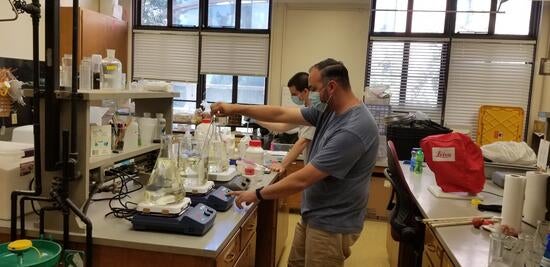
Beads are relatively easy to make and don't require expensive equipment or training in chemistry. Photo credit: Mark Hoddle, UC Riverside. |
water infused with an ultra-low concentration of insecticide being applied to the soil of a commercial citrus orchard for control of Argentine ant. Photo credit: Mike Lewis, UC Riverside. |
Cultural Control of Pest Ants in Citrus: Cultural controls are non-insecticidal management options for suppressing damaging pest populations. Examples of cultural control practices are the manipulation of planting or harvesting dates so as to reduce pest establishment, reproduction, and survival rates. With respect to managing pest ants, like Argentine ant in citrus, several cultural control options are available.
Canopy Management: One cultural control practice involves skirting trees to keep foliage off of the ground and pruning trees so that canopies do not touch. These types of foliage management reduce ant access points into canopies where sap-sucking hemipteran pests are found. Ants are attracted to these pests because they produce honeydew which ants feed on. In return for this food, ants protect their “micro-livestock” from natural enemies that kill this source of food. This food-for-protection-mutualism allows pest populations to flourish when ants are present.Canopy management forces ants to use tree trunks to reach pest hemipterans in the canopy.
Sticky Barriers: A second cultural control practice, application of sticky barriers to trunks, restricts ant movement into the canopy because ants can’t easily cross this barrier. This cultural control technique is often temporary as dust, leaves, and twigs that get stuck on the barrier form bridges over which ants can travel. Dead ants trapped in sticky material may also contribute to bridge building, eventually allowing nest mates to cross the sticky barrier to reach honeydew producing pests. Sticky barriers are expensive to apply in terms of materials and labor, and may potentially, cause trunk damage.
|
beads applied to the soil of a commercial citrus orchard. Photo credit: Mike Lewis, UC Riverside. |
irrigation lines to prevent Argentine ant workers using pipes to reach citrus trees. Photo credit: Mike Lewis, UC Riverside. |
polyethylene irrigation lines as
"super highways" to move efficiently
across the orchard floor.
Photo credit: Mark Hoddle, UC Riverside.
Irrigation Line Management: Cultural control approaches that target Argentine ant use of irrigation pipes is currently under investigation. Argentine ant is a very efficient forager and has an amazing ability to figure out the straightest routes from subterranean nests to food sources and back again. Foraging in straight lines means ants can move quickly to and from food sources. The other factor that strongly affects Argentine ant foraging behavior is the texture of the surface ants are moving over. Argentine ant prefers smooth surfaces and will avoid rough uneven terrain if smooth pathways are available. Consequently, long runs of polyethylene irrigation lines sitting on top of the soil under citrus trees satisfies both of these preferred Argentine ant foraging requirements as irrigation lines are straight over very long distances and smooth. Consequently, ants use irrigation lines as “super highways,” and they can always be found on these lines in orchards as this behavior optimizes their foraging activities (Fig. 21).
One way to reduce irrigation line use by Argentine ant is to simply cover the pipes by burying it under the soil or covering it with high quality composted organic mulch (Fig. 22). Ants cannot use the covered irrigation pipes and are forced to move over uneven terrain. This may slow their transit times, which could possibly reduce ant numbers in the canopy, thereby giving natural enemies more time to attack and kill hemipteran pests before ants interfere with them. Mulch has many benefits when applied in orchards. These benefits include improved water retention in soil, enhanced soil quality, weed control, stabilization of soil temperatures, and increased diversity of soil inhabiting natural enemies.
irrigation line in a commercial citrus orchard is being
evaluated for its ability to reduce the efficiency of pipe
use by foraging Argentine ant workers.
Photo credit: Mike Lewis, UC Riverside.
Another cultural control practice to minimize the efficiency of irrigation line use by ants is to set up “speed bumps” (Fig. 23) along the “super highway” to either force ants off of pipes or to significantly slow their transit times along pipes as they navigate their way around or over these barriers. These 3D printed structures are currently undergoing evaluation in the field for efficacy. If they work they maybe a cost-effective way to manage Argentine ant by disrupting this highly stereotypical foraging behavior on irrigation lines.
Conclusions
Argentine ant is a serious pest in citrus and other perennial crops, like grapes. The reason this pest ant is so problematic is because it protects sap sucking pest hemipterans, like Asian citrus psyllid, mealybugs, soft scales, aphids, and whiteflies from their natural enemies. In return for this protection, ants are rewarded with honeydew, a carbohydrate rich food, which is harvested and returned to subterranean nests where it is shared amongst workers and feed to non-foraging brood, queens, and male ants (i.e., drones). When ants are controlled natural enemy activity increases enormously and impressive amounts of pest control results as resident biological control agents drive pest densities to very low non-damaging levels (McCalla et al. 2023). Monitoring and controlling Argentine ant is challenging. However, monitoring of Argentine ants on irrigation lines is amenable to technology, like infra-red sensors, that automate ant counts and uploads count data to the cloud where it is accessible via an App. This approach greatly improves accuracy, is not constrained by time of day and/or work hours, and is potentially much cheaper and reliable than visual counts made by humans. Biodegradable hydrogel beads loaded with liquid bait (25% sucrose solution) infused with an ultra-low concentration of insecticide (e.g., 0.0001% thiamethoxam) applied to the soil under citrus trees where Argentine ant workers forage, is a powerful new tool for controlling these pest ants. When taken together, the future of Argentine ant control may be amenable to complete automation. For example, the IR sensors relay information on ant activity in different sectors of the orchard. If ant activity on pipes exceeds a critical density, for example and average of 100 ants per minute on pipes, then a signal is relayed to a land drone that is loaded with biodegradable hydrogel beads. The GPS coordinates in the relayed signal guide the land drone to the exact location(s) in the orchard where ant control is needed. The land drone dumps and spreads the biodegradable hydrogel beads in areas where ant control is needed. The drone then returns to its charging station and is reloaded with biodegradable gels that are auto-made onsite (i.e., think of a vending machine similar to one that makes fancy drinks from raw ingredients that are then dispensed into cups for removal and drinking away from the machine). Platoons of land drones could be auto-deployed at night when there are no humans working in orchards, temperatures are lower and humidity tends to be higher (two factors that affect longevity of hydrogel beads in the field), and sufficient time could pass overnight to satisfy re-entry interval requirements thereby allowing workers back into orchards with no disruption to work schedules. These possibilities are exciting and now achievable with existing technology.
References Cited
Bartlett, B.R. 1961. The influence of ants upon parasites, predators, and scale insects. Annals of the Entomological Society of America 5: 543–551.
Choe, D-H, D.B. Viallfuerte, and N.D. Tsutsui. 2012. Trail pheromone of the Argentine ant, Linepithema humile (Mayr) (Hymenoptera: Formicidae). PLoS One 79: e45016.
DeBach, P., C.A. Fleschner, and E.T. Dietrick. 1951. A biological check method for evaluating the effectiveness of entomophagous insects. Journal of Economic Entomolology 44: 763–766.
Hoddle, M.S., S. Singh, E. Keogh, L. Cong, Y. Li, W. Yao, F. Gomez Marco, C.D. Hoddle, N. Irvin, M. Lewis, and I. Milosavljevic. 2022. Using infra-red sensors and the internet of things to automate Argentine ant counts. CAPCA Adviser 25: 40-45.
Markin, G.P. 1970. The seasonal life cycle of the Argentine ant, Iridomyrmex humilis (Hymenoptera: Formicidae), in southern California. Annals of the Entomological Society of America 63: 1238-1242.
McCalla, K.A., I. Milosavljević, and M.S. Hoddle. 2023. A low toxicity baiting program precipitates collapse of Argentine ant and ant-associated hemipteran pest populations in commercial citrus. Biological Control 177: 105105.
Milosavljevic, I., D.J.W. Morgan, R.E. Massie, and M.S. Hoddle. 2021. Density dependent mortality, climate, and Argentine ants affect population dynamics of an invasive citrus pest, Diaphorina citri, and its specialist parasitoid, Tamarixia radiata, in southern California, USA. Biological Control 159: 104627.
Moreno, D.S., P.B. Haney, and R.F. Luck. 1987. Chlorpyrifos and diazinon as barriers to Argentine ant (Hymenoptera: Formicidae) foraging on citrus trees. Journal of Economic Entomology 80: 208–214.
Schall, K.A. and M.S. Hoddle. 2017. Disrupting the ultimate invasive pest partnership. Citrograph 8: 38–43.
Shik, J.Z. and J. Silverman. 2013. Towards a nutritional ecology of invasive establishment: aphid mutualists provide better fuel for incipient Argentine ant colonies than insect prey. Biol. Invasions 15: 829–836.
Smith, M.R. 1936: Distribution of the Argentine ant in the United States and suggestions for its control or eradication. – United States Department of Agriculture Circular 387: 1-39.
Sunamura, E., X. Espadaler, H. Sakamoto, S. Suzuki, M. Terayama and S. Tatsuki. 2009. Intercontinental union of Argentine ants: behavioral relationships among introduced populations in Europe, North Americam and Asia. Insectes Sociaux 56: 143-147.
Tena, A., C.D. Hoddle, and M.S. Hoddle. 2013. Competition between honeydew producers in an ant–hemipteran interaction may enhance biological control of an invasive pest. Bulletin of Entomological Research 103: 714–723.
Thomas, M.L., C.M. Payne-Makrisâ, A.V. Suarez, N.D. Tsutsui, and D.A. Holway. 2006. When supercolonies collide: territorial aggression in an invasive and unicolonial social insect. Molecular Ecology 15: 4303-4315.
Thomas, M.L., C.M. Payne-Makrisâ, A.V. Suarez, N.D. Tsutsui, and D.A. Holway. 2007. Contact between supercolonies elevates aggression in Argentine ants. Insectes Sociaux 54: 225-233.
Vega S.J., and M.K. Rust. 2001. The Argentine ant – a significant invasive species in agricultural, urban, and natural environments. Sociology 37: 3-25.
Wetterer, J.K., A.L. Wild, A.V. Suarez, N. Roura-Pascual, and X. Espalder. 2009. Worldwide spread of the Argentine ant, Linepithema humile (Hymenoptera: Formicidae). Myrmecological News 12: 187-194.
